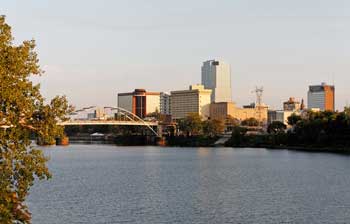ABOUT Arkansas
Capital: Little Rock
State abbreviation/Postal code: Ark./AR
Nickname: The Natural State
Origin of name: French interpretation of a Sioux word "acansa," meaning "downstream place."
Briefs on Arkansas:
 Arkansas, the land of springs certainly springs fun and excitement in the life of every visitor. The globally acclaimed Eureka Springs and Hot Springs here are known for their health enhancing features and relaxation qualities. Along with these Arkansas presents unparalleled scenic splendor, wonderful historic towns, vibrant cities, lush green valleys, thick forests, fertile plains, beautiful Deltas, crystal clear water lakes and rivers especially America's First National River, the Buffalo, rolling hills, extensive mountain wilderness areas, and much more that make it a destination worthwhile.
Arkansas, the land of springs certainly springs fun and excitement in the life of every visitor. The globally acclaimed Eureka Springs and Hot Springs here are known for their health enhancing features and relaxation qualities. Along with these Arkansas presents unparalleled scenic splendor, wonderful historic towns, vibrant cities, lush green valleys, thick forests, fertile plains, beautiful Deltas, crystal clear water lakes and rivers especially America's First National River, the Buffalo, rolling hills, extensive mountain wilderness areas, and much more that make it a destination worthwhile.
Arkansas spreads in an area of 137, 732 square kilometers and has an approximate population of 2,673,400 people. The capital of Arkansas is Little Rock. Deriving its name from a small rock formation on the south bank of the Arkansas River titled La Petite Roche meaning little rock, Little Rock is also the largest city in the region. It is located in the central Arkansas and is the county seat of Pulaski County.
 Arkansas, the only state of United States of America where diamonds are naturally found has most of its eastern border covered with the Mississippi river except in Clay and Greene counties where the St. Francis River forms the western boundary of the Missouri Bootheel. The southern border of Arkansas is with Louisiana; northern border lies with Missouri, astern border with Tennessee and Mississippi and western border with Texas and Oklahoma.
Arkansas, the only state of United States of America where diamonds are naturally found has most of its eastern border covered with the Mississippi river except in Clay and Greene counties where the St. Francis River forms the western boundary of the Missouri Bootheel. The southern border of Arkansas is with Louisiana; northern border lies with Missouri, astern border with Tennessee and Mississippi and western border with Texas and Oklahoma.
Arkansas, the only state of United States of America where diamonds are naturally found has most of its eastern border covered with the Mississippi river except in Clay and Greene counties where the St. Francis River forms the western boundary of the Missouri Bootheel. The southern border of Arkansas is with Louisiana; northern border lies with Missouri, astern border with Tennessee and Mississippi and western border with Texas and Oklahoma.
The history of Arkansas is also as exciting as the place itself. The region was first explored in 1541 by Hernando de Soto as he made his way westward from Florida in search of gold. In 1673 the French people came to this state. It was then in 1682 that the Sieur de la Salle, claimed the territory for France.
In 1686 Arkansas witnessed its first permanent settlement at the hands of Heni de Tonti, the foremost to permanently settle in the Arkansas territory at Arkansas Post. It is believed that Arkansas got its name after the Siouan-speaking people who left their allied tribes to make a tour of the Mississippi river. These people were called Ugakhpa or Quapaw.
In 1763 Arkansas went to Spain under the Treaty of Paris. But in 1800 the Treaty of San Marino Illdefonso brought it back to France. However the Spanish officials continued holding the office till 1804 when Americans occupied the Arkansas Post.
In 1812 the statehood of Louisiana was accepted. As its borders were well defined the Louisiana territory had to be renamed. Its new name was the Missouri Territory. In 1819, Missouri also applied for statehood and its appeal was accepted. As a result the territory had to be renamed once again. The land between Louisiana and Missouri then came to be known as the Arkansas territory.
In 1821 the capital of Arkansas was moved from Arkansas Post, on the Mississippi river to Little Rock, on the Arkansas River. Since that time Little Rock has served as the capital of Arkansas.
On 15th June 1836 Arkansas ratified the US Constitution and became the 25th state in the Union.
After the American Civil War, Arkansas witnessed a period of Reconstruction. In 1874 the Arkansas State Constitution was passed.
More links about Arkansas